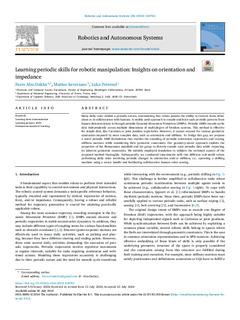
Izenburua
Learning periodic skills for robotic manipulation: Insights on orientation and impedanceArgitalpen data
2024Beste erakundeak
Università degli Studi di Trentohttps://ror.org/02e2c7k09
Bertsioa
Bertsio argitaratuaDokumentu-mota
ArtikuluaArtikuluaHizkuntza
IngelesaEskubideak
© 2024 The AuthorsSarbidea
Sarbide irekiaArgitaratzailearen bertsioa
https://doi.org/10.1016/j.robot.2024.104763Non argitaratua
Robotics and Autonomous Systems Vol. 180. N. art. 104763, 2024Argitaratzailea
ElsevierGako-hitzak
Learning from demonstrationLearning periodic skills
Riemannian manifold learning
ODS 9 Industria, innovación e infraestructura
UNESCO Sailkapena
Ordenagailuen zientziaLaburpena
Many daily tasks exhibit a periodic nature, necessitating that robots possess the ability to execute them either alone or in collaboration with humans. A widely used approach to encode and learn such ... [+]
Many daily tasks exhibit a periodic nature, necessitating that robots possess the ability to execute them either alone or in collaboration with humans. A widely used approach to encode and learn such periodic patterns from human demonstrations is through periodic Dynamic Movement Primitives (DMPs). Periodic DMPs encode cyclic data independently across multiple dimensions of multi-degree of freedom systems. This method is effective for simple data, like Cartesian or joint position trajectories. However, it cannot account for various geometric constraints imposed by more complex data, such as orientation and stiffness. To bridge this gap, we propose a novel periodic DMP formulation that enables the encoding of periodic orientation trajectories and varying stiffness matrices while considering their geometric constraints. Our geometry-aware approach exploits the properties of the Riemannian manifold and Lie group to directly encode such periodic data while respecting its inherent geometric constraints. We initially employed simulation to validate the technical aspects of the proposed method thoroughly. Subsequently, we conducted experiments with two different real-world robots performing daily tasks involving periodic changes in orientation and/or stiffness, i.e., operating a drilling machine using a rotary handle and facilitating collaborative human–robot sawing. [-]
Bildumak
Item honek honako baimen-fitxategi hauek dauzka asoziatuta:





















